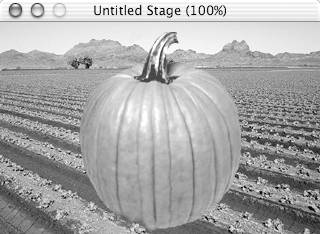Chapter 8. Compositing Images
| The Stage in Figure 8.1 shows a gigantic pumpkin sitting in a field. Needless to say, there are no pumpkins quite that large ”the image was faked by taking a photo of a pumpkin, removing its background, and placing it in front of a photo of a field to give the appearance of a unified whole. The technique of combining one or more foreground images with one or more background images in this way is called compositing . Figure 8.1. This gigantic pumpkin, superimposed against a field, is an example of compositing. In the days before computers, compositing was a difficult, expensive operation involving duplicate negatives , high-contrast photographic masks, and expensive photographic printing equipment. Even when computers changed the way compositing was done, it remained a time-consuming and processor- intensive task. One of the amazing things about Director is that it handles compositing on the fly ”with multiple layers of moving sprites ”tens or hundreds of times per second. Any time you have sprites in more than one channel ”which is to say, in just about every Director movie ”the way the foreground sprites appear against the background sprites is important. If you have a car driving across the screen, and it's surrounded by a white rectangle, or its windows are opaque , your movie won't have a convincing, professional appearance. Though compositing is relatively simple when done with vector images, compositing bitmaps is a trickier business, and this is one area where Director really shines. There are several ways to handle compositing in Director, each with its advantages and drawbacks. This chapter will take you through them. |
EAN: N/A
Pages: 139
